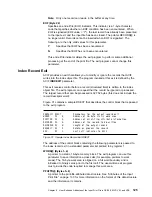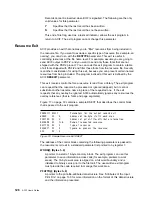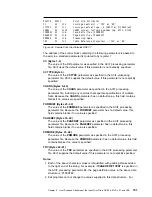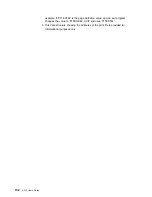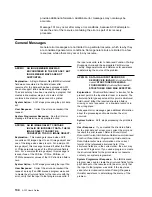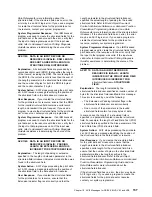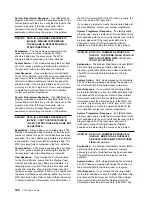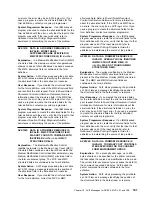
RECORD@ (Bytes 9–12)
A pointer to the first byte of the index record, including the carriage control
character. The record resides in a 32KB buffer (where KB equals 1024 bytes).
The buffer resides in storage allocated by ACIF, but the exit program is allowed
to modify the index record.
RECORDLN (Bytes 13–14)
Specifies the length, in bytes, of the index record. If the index record is
modified, this parameter must also be updated to reflect the actual length of the
record.
REQUEST (Byte 15)
Specifies how the record is to be processed by ACIF. On entry to the exit
program, this parameter is X
'
00
'
. When the exit program returns control to
ACIF, this parameter must have the value X
'
00
'
or X
'
01
'
, where:
X
'
00
'
Specifies that the record be processed by ACIF.
X
'
01
'
Specifies that the record not be processed by ACIF.
A value of X
'
00
'
on entry to the exit program specifies that the record be
processed. If you want to ignore the record, change the REQUEST byte value
to X
'
01
'
. Any value greater than X
'
01
'
is interpreted as X
'
00
'
, and the exit
processes the record.
Note: Only one record can reside in the buffer at any time.
EOF (Byte 16)
Specifies an end-of-file (EOF) indicator. This indicator is a 1-byte character
code that signals when ACIF has finished processing the index object file.
When EOF is signalled (EOF value = “Y”), the last record has already been
presented to the index exit. The pointer RECORD@ is no longer valid.
Records cannot be inserted when EOF is signalled. The following are the only
valid values for this parameter:
Y
Specifies that the last record has been written.
N
Specifies that the last record has not been written.
This end-of-file flag, used as a last call indicator, allows the exit program to
return control to ACIF. The exit program cannot change this parameter.
Output Record Exit
Using the output record exit, you can modify or ignore the records ACIF writes into
the output document file. The program invoked at this exit is defined by the ACIF
OUTEXIT parameter.
The exit receives control before a record (structured field) is written to the output
document file. The exit program can request that the record be ignored or
processed. The largest record that the exit can process is 32 752 bytes, not
including the record descriptor word. The exit is not called when ACIF is processing
resources.
Figure 32 on page 127 contains a sample DSECT that describes the control block
passed to the exit program.
126
ACIF User’s Guide
Содержание S544-5285-01
Страница 1: ...IBM Print Services Facility IBM AFP Conversion and Indexing Facility User s Guide S544 5285 01...
Страница 2: ......
Страница 3: ...IBM Print Services Facility IBM AFP Conversion and Indexing Facility User s Guide S544 5285 01...
Страница 10: ...viii ACIF User s Guide...
Страница 21: ...Part 1 Information Common to AIX OS 390 MVS VM and VSE Environments Copyright IBM Corp 1993 1999 1...
Страница 22: ...2 ACIF User s Guide...
Страница 40: ...20 ACIF User s Guide...
Страница 41: ...Part 2 Using ACIF in the AIX Environment Copyright IBM Corp 1993 1999 21...
Страница 42: ...22 ACIF User s Guide...
Страница 72: ...52 ACIF User s Guide...
Страница 96: ...76 ACIF User s Guide...
Страница 99: ...Part 3 Using ACIF in the OS 390 MVS VM and VSE Environments Copyright IBM Corp 1993 1999 79...
Страница 100: ...80 ACIF User s Guide...
Страница 106: ...86 ACIF User s Guide...
Страница 134: ...Figure 24 Example of a Customer s Phone Bill 114 ACIF User s Guide...
Страница 142: ...122 ACIF User s Guide...
Страница 196: ...176 ACIF User s Guide...
Страница 197: ...Part 4 Appendixes Copyright IBM Corp 1993 1999 177...
Страница 198: ...178 ACIF User s Guide...
Страница 206: ...186 ACIF User s Guide...
Страница 210: ...190 ACIF User s Guide...
Страница 226: ...206 ACIF User s Guide...
Страница 253: ......
Страница 255: ...Spine information IBM IBM Print Services Facility User s Guide AFP Conversion and Indexing Facility...














